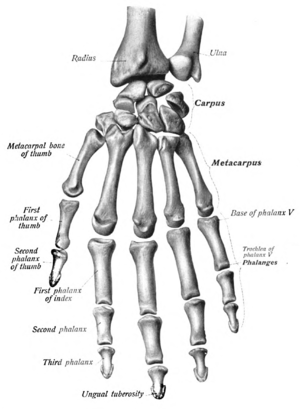Opposability
| Thumb | |
|---|---|

Bones of the thumb, visible at left.
|
|
| Details | |
| Artery | Princeps pollicis artery |
| Vein | Dorsal venous network of hand |
| Nerve | Dorsal digital nerves of radial nerve, proper palmar digital nerves of median nerve |
| Lymph | Infraclavicular lymph nodes |
| Identifiers | |
| Latin | pollex digitus I manus digitus primus manus |
| MeSH | A01.378.800.667.430.705 |
| Dorlands /Elsevier |
12655361 |
| TA | A01.1.00.053 |
| FMA | 24938 |
|
Anatomical terminology
[]
|
|
The thumb is the first digit of the hand. When a person is standing in the medical anatomical position (where the palm is facing to the front), the thumb is the outermost digit. The Medical Latin English noun for thumb is (compare hallux for big toe), and the corresponding adjective for thumb is .
The English word "finger" has two senses, even in the context of appendages of a single typical human hand:
Linguistically, it appears that the original sense was the broader of these two: penkwe-ros (also rendered as penqrós) was, in the inferred Proto-Indo-European language, a suffixed form of penkwe (or penqe), which has given rise to many Indo-European-family words (tens of them defined in English dictionaries) that involve or flow from concepts of fiveness.
The thumb shares the following with each of the other four fingers:
The thumb contrasts with each of the other four by being the only digit that:
and hence the etymology of the word: "tum" is Proto-Indo-European for "swelling" (cf "tumour" and "thigh") since the thumb is the stoutest of the fingers.
In humans, opposition and apposition are two movements unique to the thumb, but these words are not synonyms:
Primatologists and hand research pioneers John and Prudence Napier defined opposition as: "A movement by which the pulp surface of the thumb is placed squarely in contact with - or diametrically opposite to - the terminal pads of one or all of the remaining digits." For this true, pulp-to-pulp opposition to be possible, the thumb must rotate about its long axis (at the carpometacarpal joint). Arguably, this definition was chosen to underline what is unique to the human thumb.
Anatomists and other researchers focused exclusively on human anatomy, on the other hand, tend to elaborate this definition in various ways and, consequently, there are hundreds of definitions. Some anatomists restrict opposition to when the thumb is approximated to the fifth digit (little finger) and refer to other approximations between the thumb and other digits as apposition. To anatomists, this makes sense as two intrinsic hand muscles are named for this specific movement (the opponens pollicis and opponens digiti minimi respectively).
...
Wikipedia
